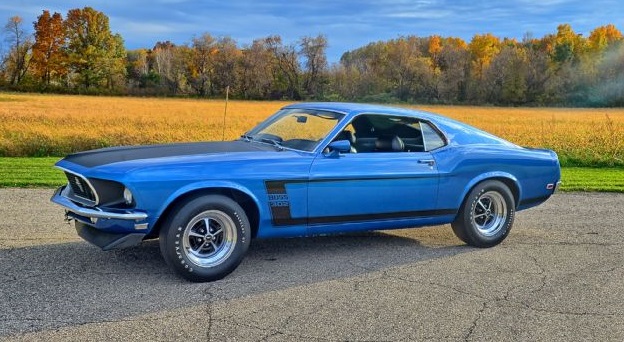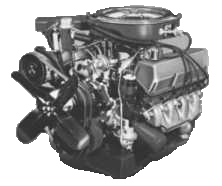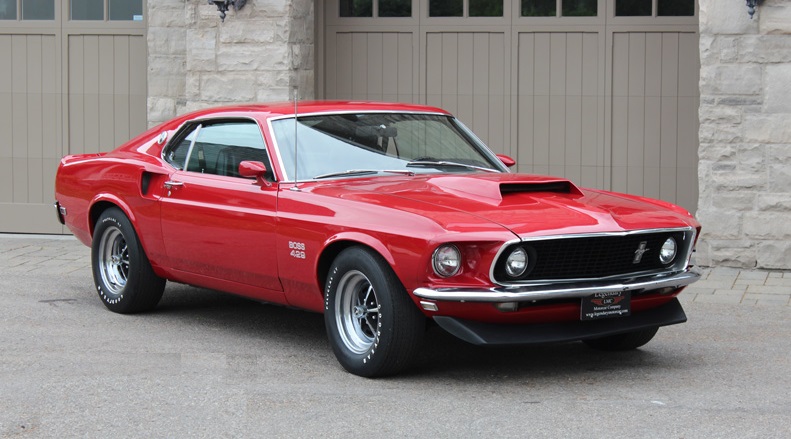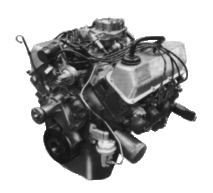Ford Mustang Boss 302 - 1969 to 1970
1969 Ford Mustang
Boss 302

|

|
1969 Ford Mustang
Boss 302

|
Ford's Boss 302 Mustang debuted in March of 1969. It's primary
purpose was to allow the Mustang SportsRoof to compete in the Sport's
Car Club of America's (SCCA) Trans-Am race series. The Boss 302 was only available
in the SportsRoof model with the 290 horsepower, 302 engine.
The heart of the Boss 302 Mustang was a specially equipped 302 cid engine
that featured specially designed heads with canted valves and high-turbulence,
wedge shaped combustion chambers. Other engine features included:
11:1 pop-up type pistons, a dual point vacuum/centrifugal advance
distributor, solid lifter camshaft, 4 bolt main bearing caps, a forged
crankshaft, and topped with a 780 CFM Holley carb. The 1969 Boss 302 models
featured 2.23 inch intake valves but this was reduced to 2.19 inch
for the 1970 Boss 302 models. The 1969 models had chrome valve covers which were
changed to aluminum on the 1970 models. Included on both models was
a rev limiter that kept the engine from over revving by cutting out
random cylinders at rpm's above 6150.
The exterior of the Mustang Boss 302 featured a front spoiler and flared
fenders to accommodate the standard F60 tires which were mounted on
15" Magnum 500 wheels in 1969 and standard 15" steel wheels with flat
hubcaps in 1970. The Magnum 500's were optional on the 1970 models.
The 1969 models had special reflective "C" stripes with "Boss 302"
in the center of the stripe on the front fenders. The 1970 model side
stripe had "Boss 302" at the top of the fender and was a continuation
of the stripe on the hood. Low-gloss black paint was used on the hood,
deck lid, rear panel, and headlight housings. The non-functional quarter
panel scoops were eliminated on the Mustang Boss 302 models.
The Boss 302 was available with any of the optional Mustang interiors
although most of them were equipped with the standard black interior.
A choke knob was mounted under the dash above the accelerator. The
4 speed shifter on the 1969 model was the standard Ford unit but was
changed to a Hurst unit on the 1970 models.
The competition suspension was standard on the Boss 302's. It
had heavy duty springs and shock absorbers (staggered shocks on the
rear), and heavier front stabilizer bar. It was also equipped with
a 16:1 steering ratio and power front disc brakes.
Some of the available options were a rear spoiler, rear window
louvre (called Sports Slats), chrome Magnum 500 wheels, and 3.50:1,
3.91:1, or 4.30:1 Traction-Loc rear end.
Ford Mustang Boss 429 - 1969 to 1970
1969 Ford Mustang
Boss 429

|

|
1970 Ford Mustang
Boss 429

|
The Boss 429 Mustang debuted in January of 1969. It was built
primarily to allow Ford to campaign the special engine in the NASCAR
racing circuit. NASCAR's rules stated that for any "trick" part or engine
to be considered legal, it had to be installed on at least 500 cars
that were sold to the public. The Mustang SportsRoof model was chosen
to house this brutal engine.
The Boss 429 engine was rated at over 370 horsepower. It featured
aluminum heads, with huge, free-flowing intake and exhaust ports,
a crescent shaped combustion chamber, and large over-sized valves
which were set at an angle so that the intake valve was close to
the intake manifold and the exhaust valve was close to the exhaust
manifold. The standard 735 CFM Holley carburetor was mounted on
a high rise intake manifold.
To allow for the extended width of this new engine, the factory
shock towers had to be moved out one inch on each side. A "mini-assembly
plant" in Brighton, Michigan called Kar Kraft, performed this and
other modifications for the Boss 429 Mustangs. The partially assembled
Mustang SportsRoofs were shipped from Ford to Kar Kraft for modification
and final assembly. Kar Kraft lowered the front A-Arms one inch,
moved the shock towers out one inch, and installed the Boss 429
engines along with a high-capacity oil cooler.
The exterior of the Boss 429 Mustang featured a massive, manually operated,
ram air hood scoop (the largest ever installed on a Mustang). The
scoop was painted the same color as the body in '69 and black on
the '70 models. A front spoiler, flared front fenders, chrome 15x7
Magnum 500's with F60x15 wide oval tires, dual color-keyed racing
mirrors and Boss 429 decals on the front fenders were all standard
equipment on the Boss 429's.
The interior of the Boss 429 Mustang was outfitted with the interior
decor group, high back "Comfortweave" buckets, the "Visibility Group"
(parking brake warning light, glove box lock, lights in the ash
tray, trunk, and glove box, and an illuminated ignition switch), deluxe
seat belts, console, tachometer, and a Ford 4 speed shifter. In
1970 Ford also included the "Convenience Group" as standard equipment
on the Boss 429. The "Convenience Group" added a parking brake warning
light, headlights-on warning buzzer, and an automatic seat back
release.
Other standard features on the Boss 429 were a competition
suspension, rear stabilizer bar, high capacity engine oil cooler,
65 amp alternator, 85 amp battery (mounted in the trunk), lowered
front A-Arms, power front disc brakes, power steering and a 3.91:1
Traction-Lok rear end.
1971 Ford Mustang Boss 351
1971 Ford Mustang Boss 351

|

|
Introduced in November of 1970, the Boss 351 Mustang became one of
the last high performance models of the Mustang line. It was based
on the Mustang SportsRoof model and replaced both the Boss 302 and the Boss
429 models. The Boss 351 engine was a 351 Cleveland four barrel
engine with a mechanical cam, solid lifters, 11.0:1 compression
ratio, aluminum intake, and a 4 bolt main bearing block. It was
topped with an all-new 750 CFM Ford 4 barrel carburetor. The Boss
351 engine produced 330 horsepower at 5400 RPM.
The exterior of the Boss 351 Mustang featured a functional Ram Air
NASA hood with built in twist-type locks and was painted either
black or argent depending upon exterior color, a front spoiler
in either black or argent, a honeycomb grille, color-keyed hood
and fender mouldings, a black or argent rear panel, dual color-keyed
racing mirrors, a body side stripe, and "Boss 351 Mustang" decals
on the fenders and deck lid. The standard wheels were 15x7 steel
wheels with flat hub caps and F60x15 tires. Most buyers, however,
opted for the chrome or argent Magnum 500's.
The Boss 351 Mustang was equipped with the standard Mustang interior,
but any of the optional Mustang interiors could be ordered. A
Hurst 4 speed shifter and the "Instrumentation Group" (tachometer,
and tripod gauges with oil pressure, alternator, and temperature)
were standard on the Boss 351 interior.
Other standard Boss 351 equipment included a four speed transmission,
competition suspension with staggered rear shocks, heavier front
stabilizer bar, power front disc brakes, extra-capacity radiator,
dual exhaust, an 80 amp battery, and 3.91:1 Traction-Lok rear
end.
|
